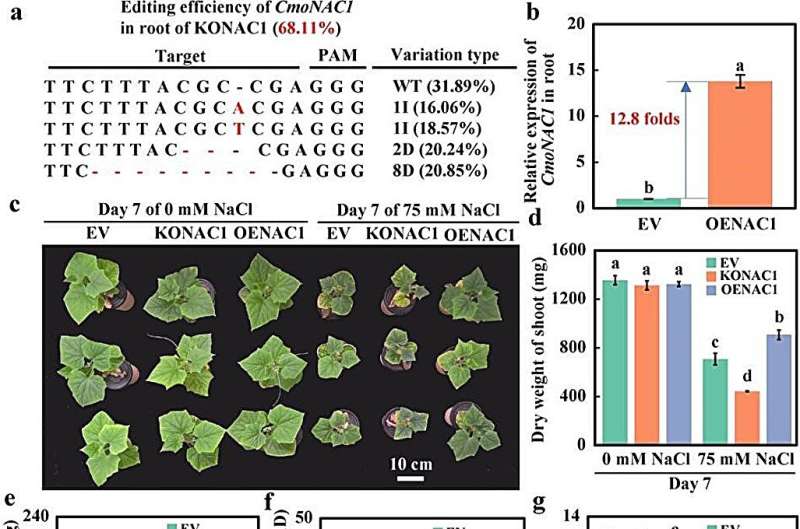This article has been reviewed according to Science X's editorial process and policies. Editors have highlighted the following attributes while ensuring the content's credibility:
fact-checked
proofread
Transcription factor's key role in grafted cucumbers reveals salt tolerance in crops

Soil salinity, impacting about 1 billion square hectometers worldwide, significantly hinders crop growth. Plants counteract this through signaling pathways involving molecules such as H2O2 and ABA. NAC transcription factors, which are unique to plants, play a central role in the regulation of these stress responses.
In grafted vegetables, such as cucumbers on pumpkin rootstocks, these factors seem crucial for enhancing salt tolerance by modulating stomatal closure. However, the detailed regulatory role of NAC factors in this context remains unclear, highlighting a vital area for research.
A study published in Horticulture Research titled "CmoNAC1 in pumpkin rootstocks improves salt tolerance of grafted cucumbers by binding to the promoters of CmoRBOHD1, CmoNCED6, CmoAKT1;2 and CmoHKT1;1 to regulate H2O2, ABA signaling and K+/Na+ homeostasis" provides new insights into improving salt tolerance in cucumbers and valuable references for molecular breeding of salt tolerant pumpkin rootstocks.
Initially, homologs of the enzyme NCED were identified in pumpkin, with CmoNCED6 emerging as the key gene for ABA synthesis under salt stress. The analysis of transcription factors binding to the promoters of CmoRBOHD1 and CmoNCED6 identified CmoNAC1 as a significant regulator.
Root transformation experiments demonstrated that CmoNAC1 knockout resulted in decreased H2O2, ABA content, and K+/Na+ ratio in grafted cucumbers, while overexpression had the opposite effect, confirming CmoNAC1's role in enhancing salt tolerance.
Further research has shown that CmoNAC1 affects the production of H2O2 and ABA in grafted cucumber leaves and roots by regulating the expression of CsaRBOHD, CsaNCED3, CmoRBOHD1, and CmoNCED6, thereby regulating physiological responses under salt stress.
In addition, this study validated the important role of CmoNCED6 in salt tolerance of grafted cucumbers, particularly in influencing ABA signal transduction, stomatal regulation, and ion balance regulation. CmoNAC1 can bind to the promoters of CmoRBOHD1, CmoNCED6, CmoAKT1;2, and CmoHKT1;1, thereby regulating their expression.
This binding was confirmed using yeast one-hybrid, luciferase, and electrophoretic mobility shift assays. The regulatory effect of CmoNAC1 on K+/Na+ transporters under salt stress was also established, showing that knockout and overexpression of CmoNAC1 significantly altered the expression of key transporters.
In conclusion, this research demonstrated that CmoNAC1 is a pivotal transcription factor in grafted cucumbers, contributing to salt tolerance by regulating H2O2 and ABA signaling and K+/Na+ homeostasis. This discovery adds valuable knowledge to the field of plant biology and agricultural practices, particularly in the context of enhancing crop resilience to environmental stressors such as soil salinity.
More information: Yuquan Peng et al, CmoNAC1 in pumpkin rootstocks improves salt tolerance of grafted cucumbers by binding to the promoters of CmoRBOHD1, CmoNCED6, CmoAKT1;2 and CmoHKT1;1 to regulate H2O2, ABA signaling and K+/Na+ homeostasis, Horticulture Research (2023). DOI: 10.1093/hr/uhad157
Provided by TranSpread



















